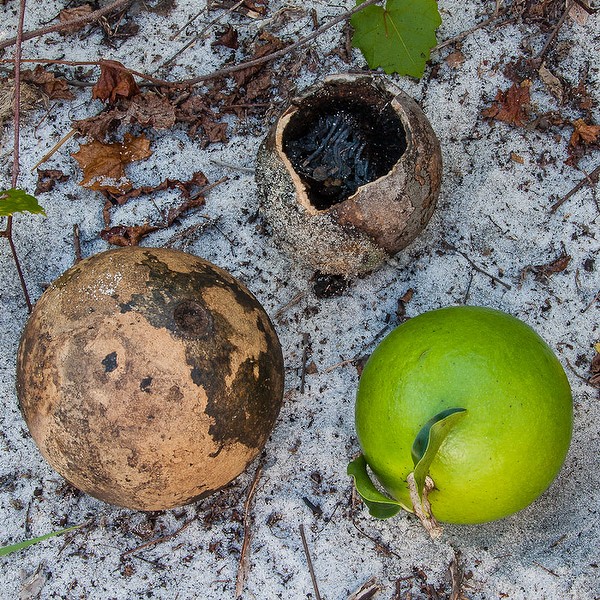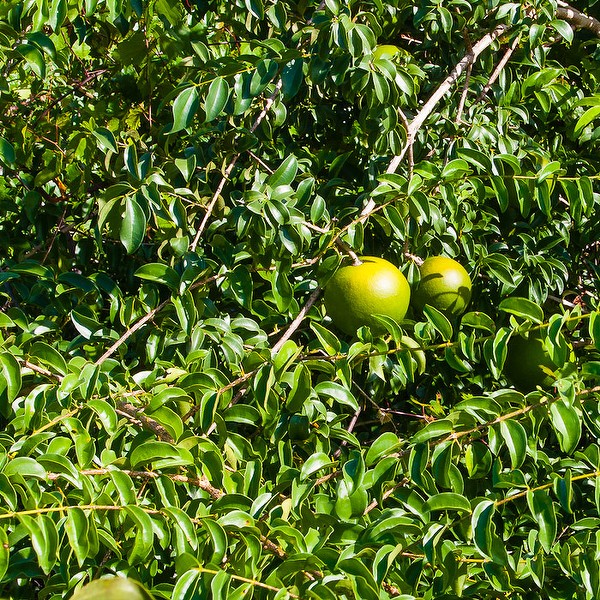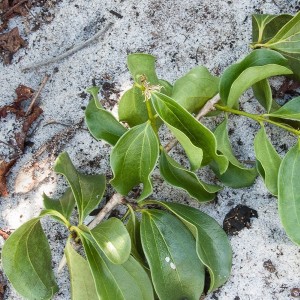Monkey-Orange
Strychnos spinosa
Loganiaceae
In recent weeks John and George have focused on the beautiful Savannas Preserve State Park and its neighborhood around Jensen Beach, partly in preparation for an upcoming workshop there, partly because it beats working. During all those doings, John, Park Biologist Christopher Vandello, and George teamed up to identify an invasive exotic shrub with croquet-ball fruits. Christopher has been restoring a lovely sugar sand scrub ridge crossed by an ancient paved road with a simultaneous view of the Intracoastal and the inland “savannas” marsh. Unfortunately this primo piece of creation is exotically invaded with the spawn of garden waste dumped long ago: Sansevieria, feral ornamental bromeliads, Suriname-Cherry, Callisia, Kalanchoe, and more. The most striking and spreading unwelcome guest is a thorny sprawling shrub resembling at first glance Snowberry (Chiococca) but with cannonball fruits the size and shape of grapefruits and rock hard.
Many species in the world have fruits of that general sort, perfect for throwing, and they’d be fun to step back 50 feet and shoot with a .22. They look just like the citrus Bael Fruit (Aegle), but the foliage is wrong. They look like some lemonish citrus, but the foliage is all wrong. They look like Calabash, but the foliage is all wrong. We took some prickly branches and vegetable bocce balls back to park headquarters, went to work on the computer, and they turned out to be “Monkey-Oranges” (Strychnos spinosa). Another name is Natal-Oranges, fitting as the site has a meadow of Natal Grass (Melinis).

If we were in Africa these would be elephant snacks. People make things out of those hard “gourd” shells. (By JB)
The foliage is distinctive with opposite leaves having long smoothly upcurved veins. Monkey-Oranges are not even related to Sunkist, but rather are (debatably) in the Loganiaceae, more familiar to Florida native plant enthusiasts for Spigelia and Mitreola, and (debatably) Polypremum. This is the family of the super-uber-lethal Carolina-Jessamine (Gelsemium).
That “lethal” part fits Strychnos spinosa. The genus Strychnos is the source of the alkaloid drug strychnine, mostly (but not entirely) from the species Strychnos nux-vomica. How does strychnine crop up in everyday life? Rat poison. Or if you are roughly of my “Woodstock” age you may recall exhortations from some authorities in the 1960s, “shun the LSD!, it is laced with strychnine.” Whether or not that was ever true, strychnine is a powerful drug in the alkaloid group along with its friends likewise ending in –ine, such as morphine, codeine, nicotine, atropine, and an alkaloid I’m enjoying now as I type (you guess). Strychnine inhibits the shut-off mechanism for nerve-muscle signals. A high dose is a path to boot hill. Lower controlled doses can be therapeutic, which brings us back to Strychnos spinosa.
In its native Africa the tree serves as a traditional neurological drug, applied, among other things for snakebites. Could this be a manifestation of the genuine beneficial potential of strychnine?
The fruits also serve as food, with the extra benefit of coming in a natural “can” (that steel shell) thwarting competing critters (although big animals munch freely), bugs, and decay. They hold up in storage for months. I’m not hankering to savor the flavor of strychnine-laced fruits, but cultures who have been doing it for a few millennia have the hang of it. A little superficial Google research seems to indicate that strychnine is in the seeds and in the green fruits but that ripe ones are probably more or less okay. (Forget it!)
The natural habitats— just like the Savannas State Park scrubby dunes—are desert-ish, although proximity to water seems favorable. The tolerance for aridity, the indestructible fruits, and easy wood production make Strychnos spinosa a candidate for cultivation in dry lands, such as Israel where the tree is in cultivation. In this interesting link, see Figures 7 and 8 taken in Israel yet also illustrating the scene in Savannas State Park yesterday. CLICK

